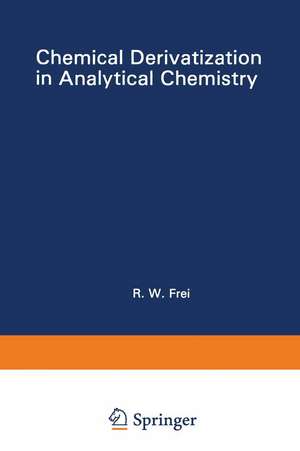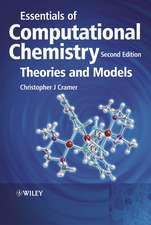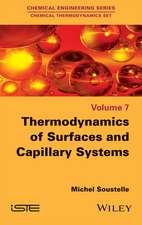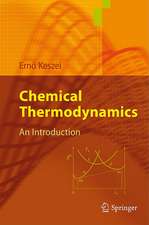Chemical Derivatization in Analytical Chemistry: Separation and Continuous Flow Techniques: Monographiae Biologicae
Editat de R. W. Freien Limba Engleză Paperback – 27 dec 2012
| Toate formatele și edițiile | Preț | Express |
|---|---|---|
| Paperback (2) | 388.34 lei 6-8 săpt. | |
| Springer Us – 27 dec 2012 | 388.34 lei 6-8 săpt. | |
| Springer Us – 24 dec 2012 | 391.79 lei 6-8 săpt. |
Din seria Monographiae Biologicae
- 24%
 Preț: 2612.51 lei
Preț: 2612.51 lei - 18%
 Preț: 948.92 lei
Preț: 948.92 lei - 15%
 Preț: 648.74 lei
Preț: 648.74 lei -
 Preț: 397.59 lei
Preț: 397.59 lei - 28%
 Preț: 91.90 lei
Preț: 91.90 lei -
 Preț: 379.86 lei
Preț: 379.86 lei -
 Preț: 414.91 lei
Preț: 414.91 lei -
 Preț: 395.47 lei
Preț: 395.47 lei -
 Preț: 389.49 lei
Preț: 389.49 lei -
 Preț: 401.24 lei
Preț: 401.24 lei -
 Preț: 394.71 lei
Preț: 394.71 lei -
 Preț: 405.99 lei
Preț: 405.99 lei -
 Preț: 425.84 lei
Preț: 425.84 lei -
 Preț: 381.21 lei
Preț: 381.21 lei -
 Preț: 389.56 lei
Preț: 389.56 lei - 18%
 Preț: 1833.65 lei
Preț: 1833.65 lei - 18%
 Preț: 1230.35 lei
Preț: 1230.35 lei - 18%
 Preț: 1027.08 lei
Preț: 1027.08 lei -
 Preț: 399.67 lei
Preț: 399.67 lei - 18%
 Preț: 2493.72 lei
Preț: 2493.72 lei -
 Preț: 417.59 lei
Preț: 417.59 lei -
 Preț: 404.89 lei
Preț: 404.89 lei - 20%
 Preț: 557.46 lei
Preț: 557.46 lei -
 Preț: 418.76 lei
Preț: 418.76 lei -
 Preț: 408.37 lei
Preț: 408.37 lei - 15%
 Preț: 650.69 lei
Preț: 650.69 lei - 15%
 Preț: 652.31 lei
Preț: 652.31 lei -
 Preț: 395.37 lei
Preț: 395.37 lei - 18%
 Preț: 1232.26 lei
Preț: 1232.26 lei - 15%
 Preț: 637.59 lei
Preț: 637.59 lei - 18%
 Preț: 1231.95 lei
Preț: 1231.95 lei - 18%
 Preț: 1226.90 lei
Preț: 1226.90 lei - 15%
 Preț: 658.22 lei
Preț: 658.22 lei -
 Preț: 353.75 lei
Preț: 353.75 lei - 18%
 Preț: 1224.36 lei
Preț: 1224.36 lei -
 Preț: 386.22 lei
Preț: 386.22 lei - 20%
 Preț: 723.22 lei
Preț: 723.22 lei - 15%
 Preț: 652.49 lei
Preț: 652.49 lei - 18%
 Preț: 1228.62 lei
Preț: 1228.62 lei - 18%
 Preț: 945.30 lei
Preț: 945.30 lei - 18%
 Preț: 1231.64 lei
Preț: 1231.64 lei - 15%
 Preț: 633.68 lei
Preț: 633.68 lei - 20%
 Preț: 572.09 lei
Preț: 572.09 lei - 18%
 Preț: 1844.54 lei
Preț: 1844.54 lei -
 Preț: 386.61 lei
Preț: 386.61 lei
Preț: 388.34 lei
Nou
Puncte Express: 583
Preț estimativ în valută:
74.32€ • 77.30$ • 61.35£
74.32€ • 77.30$ • 61.35£
Carte tipărită la comandă
Livrare economică 15-29 aprilie
Preluare comenzi: 021 569.72.76
Specificații
ISBN-13: 9781468442045
ISBN-10: 146844204X
Pagini: 316
Ilustrații: XII, 298 p.
Greutate: 0.42 kg
Ediția:Softcover reprint of the original 1st ed. 1982
Editura: Springer Us
Colecția Springer
Seria Monographiae Biologicae
Locul publicării:New York, NY, United States
ISBN-10: 146844204X
Pagini: 316
Ilustrații: XII, 298 p.
Greutate: 0.42 kg
Ediția:Softcover reprint of the original 1st ed. 1982
Editura: Springer Us
Colecția Springer
Seria Monographiae Biologicae
Locul publicării:New York, NY, United States
Public țintă
ResearchCuprins
1. Flow Injection Analysis.- 1. Introduction.- 2. Basic Principles of FIA.- 3. Essential Components of an FIA System.- 4. The Development and Performance of a Basic FIA System.- 5. Controlled Dispersion.- 6. Stopped-Flow and Intermittent Pumping.- 7. Sample Gradient Methods.- 8. Two-Phase Methods—Extraction.- 9. Some Special Manifolds and Applications.- 10. Detection Principles.- References.- 2. Ion-Pairing Reactions in Analytical Chemistry.- 1. Introduction.- 2. Principles of Ion-Pair Extraction.- 3. Batch Extraction.- 4. Continuous-Flow Systems.- 5. Ion-Pair Chromotagraphy.- References.- 3. Immobilized Enzymes as Precolumn and Postcolumn Modification Reagents in Liquid Chromatography.- 1. Introduction.- 2. Characteristics of Enzyme Catalysis.- 3. Immobilized Enzyme Technology.- 4. Theoretical Aspects of Enzyme Reactors.- 5. Applications.- References.- 4. Resolution of Optical Isomers by Gas and Liquid Chromatography Structure Requirements of Sorbents and Solutes for Enantioselective Molecular Interactions.- 1. Why the Growing Interest in Separation Methods of Racemates?.- 2. Background on Optical Isomerism.- 3. Principles of Enantioselective Chromatographic Separation Mechanisms.- 4. Resolution of Racemates by Gas-Chromatography.- 5. Direct LC Resolution Methods of Racemates.- 6. Indirect Chromatographic Separation of Racemates.- 7. Conclusion.- References.- 5. Prechromatographic Chemical Derivatization in Liquid Chromatography.- 1. Introduction.- 2. Fluorescence Derivatization.- 3. uv-Visible-Absorbance Derivatization.- 4. Derivatization for Other Detection Modes.- References.- 6. The Pros and Cons of Derivatization in the Chromatographic Determination of Food Additives.- 1. Introduction.- 2. Emulsifiers and Stabilizers.- 3. Artificial Sweeteners.- 4.Antioxidants.- 5. Preservatives.- 6. Synthetic Food Colors.- 7. Gums.- 8. Waxes.- References.











